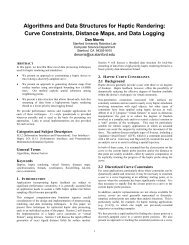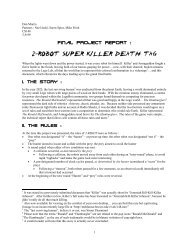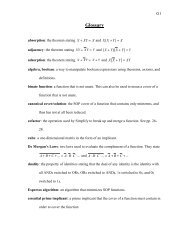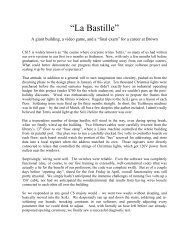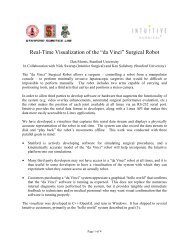The WoL Index: Quantifying Incomprehensibly Bad Popular Music
The WoL Index: Quantifying Incomprehensibly Bad Popular Music
The WoL Index: Quantifying Incomprehensibly Bad Popular Music
Create successful ePaper yourself
Turn your PDF publications into a flip-book with our unique Google optimized e-Paper software.
<strong>The</strong> <strong>WoL</strong> <strong>Index</strong>:<br />
<strong>Quantifying</strong> <strong>Incomprehensibly</strong> <strong>Bad</strong> <strong>Popular</strong> <strong>Music</strong><br />
ABSTRACT<br />
Warren Zevon’s “Werewolves of London” is a horrid song,<br />
yet has enjoyed sustained popularity for an inexplicably<br />
long period. While it is beyond the scope of this work to<br />
quantify how bad this song is, we attempt to quantify how<br />
inexplicable its popularity is, by introducing the “<strong>WoL</strong><br />
<strong>Index</strong>”, a numeric measure of how surprised an intelligent<br />
person would be to find out how long a horrid, forgettable<br />
piece of garbage like “Werewolves of London” has<br />
received regular airtime on classic rock radio. We apply this<br />
measure to other pieces of popular media and discuss<br />
potential extensions of this approach.<br />
Author Keywords<br />
Werewolves, London, Warren Zevon, Awful, Horrid<br />
ACM Classification Keywords<br />
J.5.Arts and Humanities: <strong>Music</strong>.<br />
INTRODUCTION<br />
Since the introduction of recorded media in the early part of<br />
the 20 th century, quantifying the popularity of music and<br />
video has been central to the entertainment industry. Sales<br />
charts are used to drive business in any industry, but the<br />
consumer’s obsession with sales figures and popularity is<br />
unique to the entertainment industry. Albums are sorted by<br />
popularity in both physical and online stores, and weekly<br />
“countdown” shows – organized around quantifiable<br />
popularity metrics – have long been a staple of American<br />
radio. Significant effort is made not only to quantify the<br />
objective (sales), but to quantify the subjective: awards are<br />
given for the “best” music and video productions each year.<br />
However, for all the emphasis placed on quantifying the<br />
good, only limited effort is placed on quantifying the bad.<br />
This is not because we aren’t culturally interested in “bad”:<br />
Schadenfreude is the American way, as evidenced by<br />
reality television’s increasing devotion to criticism of subpar<br />
characters and performances.<br />
Rather, it is our hypothesis that we avoid quantifying the<br />
“bad” in popular media because the question of “what is<br />
Copyright is held by the author/owner.<br />
Dan Morris<br />
Studio Cobbler<br />
dmorris@cs.stanford.edu<br />
1<br />
Figure 1: Warren Zevon’s “Werewolves of London”,<br />
represented graphically here by a picture of Warren Zevon<br />
(lower-right) next to a werewolf (center), is a horrible<br />
abomination that has received regular airplay for nearly 35<br />
years. It is thus the standard by which we will evaluate all<br />
popular media whose popularity has lasted an<br />
incomprehensibly long time.<br />
bad?” is ill-posed. Whether we use objective or subjective<br />
measures, it is almost impossible to define what we should<br />
include in our pool for judgment when considering the<br />
“worst” of popular media. Every day, thousands of garage<br />
bands create recordings that are neither “good” nor “bad”,<br />
they’re just “not a thing”, and are beyond the scope of<br />
popular evaluation.<br />
In this work, we attempt to replace “how bad is [x]?” with a<br />
more quantitative question: “how surprisingly bad is [x]?”.<br />
We use “Werewolves of London”, which is horrid and<br />
awful, as a case study to motivate, define, and evaluate this<br />
metric.<br />
WEREWOLVES OF LONDON<br />
In order to help the reader understand the rationale behind<br />
the <strong>WoL</strong> index, we briefly discuss the history and content<br />
of “Werewolves of London” here.<br />
History<br />
“Werewolves of London” 1 was composed by LeRoy<br />
Marinell, Waddy Wachtel, and Warren Zevon; the exact<br />
1 …which is awful and horrid.
ole of each composer is not documented. It is also not<br />
known how it reached number 21 on the American Top 40<br />
charts in April of 1978, when clearly no one would<br />
purchase this detestable, unlistenable single.<br />
Time wasted<br />
Its full length is three minutes and twenty-seven seconds, so<br />
we can approximate the total time this miserable, ridiculous<br />
piece of garbage has sucked from American radio as<br />
follows:<br />
Twasted = 3.5 × PR × Ns × 365 × 35<br />
Here Twasted is the time wasted on American airwaves in<br />
minutes, 3.5 is the length of the song, PR is the number of<br />
times it’s played on average on a classic rock radio station<br />
per day, Ns is the approximate number of classic rock radio<br />
stations in the U.S., and 35 is the approximate number of<br />
years we’ve had to listen to “Werewolves of London”.<br />
Using PR=1 and Ns=500 (both conservative), we compute:<br />
Twasted = 22,356,250 minutes<br />
Lyrics<br />
For brevity, we do not reproduce the full lyrics of<br />
“Werewolves of London” here. However, to help<br />
unfamiliar readers understand how ridiculous this song is,<br />
we reproduce the complete lyrics to the chorus in Figure 2,<br />
where “Aaoooooo” represents an absurd howling sound.<br />
Inexplicability of <strong>Popular</strong>ity<br />
<strong>The</strong>re are several reasons why a song this terrible (see<br />
Figure 2) might enjoy sustained popularity. We explore<br />
each of those here, finding no correlation with<br />
“Werewolves of London”.<br />
1. <strong>Popular</strong>ity of artist. If, for example, U2 released a<br />
subjectively sub-par single that achieved sustained<br />
popularity, this would be easily explained by devoted<br />
fans’ interests in supporting the band and exploring<br />
their entire catalog. This does not apply here, because,<br />
without loss of generality, there are no other songs by<br />
Warren Zevon, and there are no Warren Zevon fans.<br />
2. “Rock blocks” 2 . <strong>The</strong> “rock block” is a staple of classic<br />
rock radio, and it is not unusual for a band with two<br />
popular songs to enjoy sustained popularity for a third<br />
on the basis that DJs need to complete such a block.<br />
This also does not apply here, because, as per (1)<br />
above, there are no other songs by Warren Zevon.<br />
3. Holidays. Songs will often last beyond their expected<br />
lifetimes in the popular eye if they are recalled every<br />
year because of a specific holiday association: though<br />
the author is a huge Paul McCartney fan, “Wonderful<br />
2 Also called “Two-for Tuesdays”, “Three-for Thursdays”,<br />
“Favorites Fridays”, “Block Party Weekends”, and “Play a<br />
Bunch of Songs by the Same Artist Mondays”.<br />
2<br />
Christmastime” is also not very good, but has achieved<br />
popularity because there are only so many classic rock<br />
Christmas songs. While one might draw a loose<br />
association between Halloween and “Werewolves of<br />
London”, the evidence does not bear out this<br />
association: this song is played all year on classic rock<br />
radio.<br />
We thus conclude that the sustained popularity of<br />
“Werewolves of London” is completely inexplicable.<br />
RELATED WORK<br />
Aaoooooo!<br />
Werewolves of London!<br />
Aaoooooo!<br />
Aaoooooo!<br />
Werewolves of London!<br />
Aaoooooo!<br />
Figure 2: <strong>The</strong> complete lyrics to a single chorus of<br />
“Werewolves of London”.<br />
Assessing Werewolves of London<br />
We are aware of only one piece of previous literature<br />
exploring the terribleness of “Werewolves of London”.<br />
NPR staff et al. [1] chronicle the assessment of NPR<br />
listener Christina Pappas, who states:<br />
“You know, if our parents are listening to songs with<br />
this kind of nonsensical lyrics, then how can we ever<br />
hope to inherit a better world [from] them?”<br />
Another critical piece of assessment comes from co-writer<br />
and guitarist Waddy Watchel, who states in [2] that:<br />
“We got a decent track, but there was something<br />
lacking in it. It didn't sound stupid enough.”<br />
Assessing <strong>Bad</strong> Media<br />
Other work attempts to measure the undesirability of<br />
popular media, though only through subjective assessment<br />
of the content itself. <strong>The</strong> most objective assessment that we<br />
are aware of is Blender Magazine’s assessment (later<br />
chronicled and repeated by Rolling Stone in [3]) of “We<br />
Built This City on Rock and Roll” as the worst song of the<br />
1980s, on the objective grounds that it is a mind-blowingly<br />
corporate song denouncing the commercialization of rock<br />
and roll. Blender Magazine states this as follows:<br />
“It purports to be anti-commercial but reeks of ‘80s<br />
corporate-rock commercialism. It’s a real reflection<br />
of what practically killed rock music in the ‘80s.”<br />
While accurate, this is an extremely rare case of applying<br />
rational, objective criteria to quantify the degree to which<br />
one would not want to experience a particular piece of<br />
popular media.
Name ypopular yexpected <strong>WoL</strong> index Description<br />
Werewolves of London (Warren Zevon) 35 0 36 Inexplicable<br />
Two Princes (Spin Doctors) 5 5 1 About right<br />
A Day in the Life (<strong>The</strong> Beatles) 45 75 1 About right<br />
My Brave Face (Paul McCartney) 5 15 0.375 Underrated<br />
Table 1: <strong>The</strong> <strong>WoL</strong> index computed for several popular pieces of music. Estimations of ypopular and yexpected are completely<br />
arbitrary and unsubstantiated.<br />
THE WOL INDEX<br />
Definition<br />
Here we formally present the <strong>WoL</strong> index, which describes<br />
how inexplicable the popularity of “Werewolves of<br />
London” is. Specifically, we formulate the <strong>WoL</strong> index W<br />
as follows:<br />
W = (ypopular + 1) / (min(yexpected,dt) + 1)<br />
Here ypopular is the number of years a piece of media remains<br />
popular, defined, for example as “receiving greater than<br />
1000 plays nationally in a year”. yexpected is the number of<br />
years a sensible person would expect a piece of media to be<br />
popular. dt is the number of years elapsed since the media<br />
was released, i.e. the maximum possible value for yexpected.<br />
All are rounded up to the nearest integer, though W is<br />
continuous.<br />
<strong>The</strong> <strong>WoL</strong> index is defined as “1.0” for media that have been<br />
available less than three years. This yields the same <strong>WoL</strong><br />
index for all “new media” that is assigned to media that<br />
achieved a “just-about-right” run of popularity.<br />
Examples<br />
Table 1 presents several examples of the <strong>WoL</strong> index<br />
measured for popular media.<br />
A piece of media that has been popular for about as long as<br />
one would expect is assigned a <strong>WoL</strong> index of 1. For<br />
example, “Two Princes” by the Spin Doctors had a sensible<br />
run of about five years. It’s pretty good, but is no “A Day in<br />
the Life”.<br />
3<br />
“Werewolves of London” has a ypopular of 35, and a yexpected<br />
of 0, and therefore has a <strong>WoL</strong> index of 36. We know of no<br />
media with a <strong>WoL</strong> index greater than 36.<br />
FUTURE WORK<br />
In future work, we hope to generalize this approach to other<br />
media, particularly film. We hypothesize that a similar<br />
method will apply to film based not on expected years of<br />
popularity (because the nature of the medium prevents<br />
theater runs longer than 1 year), but rather based on<br />
anticipated quality. For example, “Indiana Jones and the<br />
Kingdom of the Crystal Skull” should have been amazing,<br />
but it was unwatchable from the first minute to the last.<br />
Future work will attempt to quantify this phenomenon.<br />
REFERENCES<br />
1. NPR Staff. “From Scorn for Zevon, a Father-Daughter<br />
Moment is Born.”<br />
http://www.npr.org/2012/07/26/157429964/from-scornfor-zevon-a-father-daughter-moment-is-born,<br />
2012.<br />
2. Correa, N. Waddy Wachtel: “Creating ‘Werewolves of<br />
London’”. http://waddywachtelinfo.com/Nina1.html<br />
3. Rolling Stone. Readers' Poll: <strong>The</strong> 10 Worst Songs of the<br />
1980s. June 2011.




